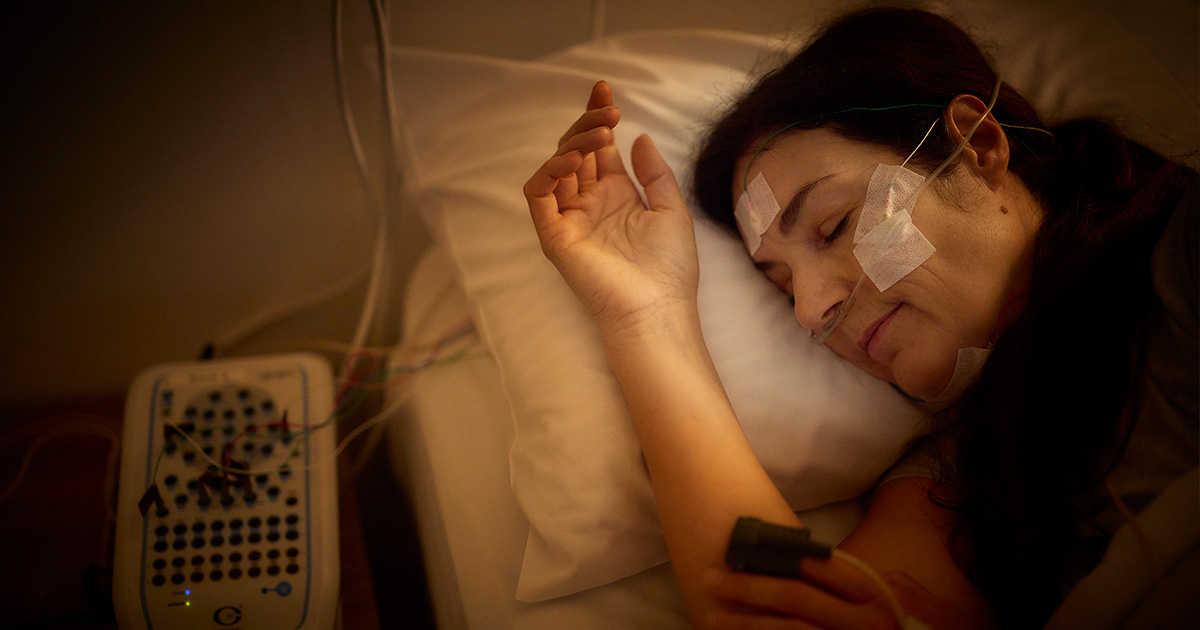The Woolcock Institute of Medical Research

Sleep studies - All you need to know
Kathy Zvirblis is a neurophysiology scientist in the Woolcock Clinic’s sleep laboratory. Here, she addresses common concerns about sleep studies.
What is the biggest concern for people having a sleep study?
Most people ask, “am I actually going to be able to sleep?” The first part of the answer to that is we have double beds and comfortable rooms with private ensuites – like a hotel room, not a hospital ward with someone in the bed next to them. Our facilities are probably a lot newer than in many other places and we make them as comfortable as possible in terms of the environment.
Second, if they’re concerned about being away from their home comforts – their pillow, their mattress – we tell them to bring their own pillow, they could bring in a mattress topper or a noise machine, anything from home that's normal for them. It won’t be their own bed but many of our patients tell us that our mattresses are comfortable.
How long does the process take?
When we set up a sleep study, the technician will carefully and precisely apply sensors to investigate your sleep. These need to be in specific locations, so the process can take up to an hour. After this, the technician will monitor the signal quality from the control room throughout the night. The only time they come back into the room overnight is if a sensor does come off and they do that without turning the lights on, quietly with very minimal disturbance. If they don't have to go in, they won't. If it's something that's quite important, then they will go in.
Won’t I get tangled up in all those wires?
When people see a picture of a sleep study, they see the wires coming off everywhere and think “am I going to be able to sleep with all this on”. For a small percentage of people, they will find it uncomfortable and probably not get as good of a quality of sleep as they would at home. For everybody else, there's no problem at all. The way that we wire everything up ensures the wires aren't obtrusive. While you're sleeping, the device is tucked away in the corner and there's enough leeway on all the wires so that you can move comfortably, not be restricted in the bed and not enough for you to get tangled up in them. That's all explained when our patients arrive for their sleep study.
Want to stay up to date with our research on sleep and respiratory conditions?
Sign up to our quarterly newsletter
What if I'm worried about my sleep study?
It’s normal to have concerns about your sleep study. It’s our sleep technicians’ job to make you feel comfortable from the moment you walk through the door. People generally come straight out with all their concerns and the experience of our staff, their level of training and our emphasis on patient comfort means we are we know how to make sure that their needs are accommodated wherever possible.
What about children (and their parents)?
When we work with children, we have to manage the anxiety of both the child and the parent and make sure we get the reading we need.
Our staff are very well versed in working with children, the level of experience they have is unmatched. Often, we’ll have a parent who says ‘look, my child's not going to cooperate with this, they’re going to be pulling the wires off after an hour’. Our staff are able to allay their fears and magically just get everything on the child without any hassles whatsoever.
Before they come in, we stress that they should bring any distractions that will help, any little thing that will occupy their child while we put everything on. Our sleep labs are designed to feel like home not a hospital. Our technicians don't wear lab coats, they’re trained professionals and they know how to work with children.
For paediatric sleep studies, the parent is in the room with the child the whole time, in their own separate bed. We have stickers with little cartoon cats on them, and we explain that the sensors are put on with just another type of sticker. Everything is just a sticker, there’s no needles, nothing that's going to hurt. Even when we take the sensors off, it doesn't hurt. Some of them are on the skin but a lot of them go on top of their pyjamas. It’s all stuff that they can see, they can touch.
What happens if something goes wrong?
If a sensor falls off during the night, that’s fine. Our sleep technicians can deal with that.
A successful sleep study is a combination of what the sleep technician does in the night and what we do, as sleep scientists, to analyse the results afterwards.
I assess our paediatric sleep studies, and I do that with 20 years’ paediatric experience. It’s a matter of knowing what information is most valuable; what do we look at a bit more closely; what isn't as important. It's being able to put the pieces together of what we're seeing. As a result we are able to produce the information the doctor needs to help you and your child with their sleep.










